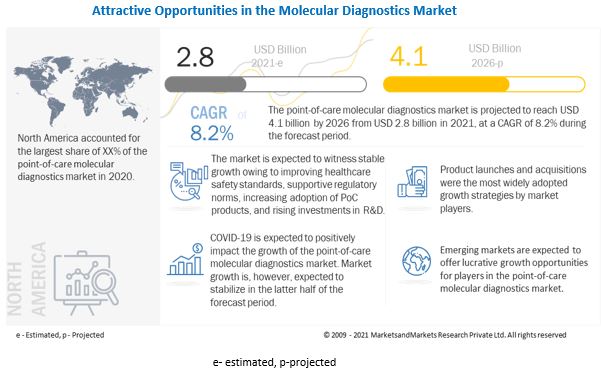A new report titled, “Global Point of Care Molecular Diagnostics Market”, has been added by MarketsandMarkets™ INC to its vast database of research reports. The Global Point of Care Molecular Diagnostics Market is poised to grow at a CAGR of 8.2% during the forecast period, 2021-2026. This intelligent study provides the definition, description, and the overall forecasts of the global market, considering the market segments and sub-segments, which includes the product types, technologies, end-users, industry verticals, and the key geographies.
Browse 200 market data Tables and 44 Figures spread through 233 Pages and in-depth TOC on “Point of Care Molecular Diagnostics Market by Product (Assays, Kits, Analyzers, Service), Application (Respiratory Diseases, HAIs, STDs, Cancer, Hepatitis), Technology (RT-PCR, INAAT), End User (Physician Office, Hospitals, ICUs) – Global Forecast to 2026”
The report examines the global market with respect to the industry trends, growth rate, prospects, drivers, restraints, threats, and lucrative opportunities, by means of distinguishing the high-growth segments of the market through the various stakeholders. The statistical surveying study also elucidates the different strategies, collaborations, merger and acquisitions, product launches, innovations, and the activities in the R&D sector in the Global Point of Care Molecular Diagnostics Market.
Request a Sample copy of Point of Care Molecular Diagnostics Study: https://www.marketsandmarkets.com/requestsampleNew.asp?id=143524127
The report presents a lucid picture of the current industry landscape, including the historical and projected market size, based on value, technological innovations, micro- and macroeconomic components, and governing factors in the market. The global Point of Care Molecular Diagnostics market research report ends with the brief summary of the leading players operating in the market, their product offerings, key developments, SWOT analysis, invest feasibility and returns, and the growth trends and forecasts.
Some of key players:
- Abbott Laboratories (US)
- Hoffmann-La Roche Ltd. (Switzerland)
- bioMérieux SA (France)
- Danaher Corporation (US)
- Quidel Corporation (US)
- QIAGEN N.V. (Netherlands)
- Co-Diagnostics, Inc. (US)
- Biocartis NV (Belgium)
- Meridian Bioscience, Inc. (US)
- Thermo Fisher Scientific, Inc. (US)
- Lucira Health, Inc. (US)
- Cue Health (US)
- OpGen, Inc. (US)
- Binx Health, Inc. (US)
- Molbio Diagnostics Pct. Ltd. (India)
- Genomadix (Canada)
- Visby Medical, Inc. (US)
- QuikPath PTE Ltd. (Singapore)
- MD-Bio (US)
- QuantuMDx Group Ltd. (UK)
- Aidian Oy (Finland)
- GeneSTAT Molecular Diagnostics, LLC (US) and Among Others
Point of Care Molecular Diagnostics Industry – Key Companies Insight:
Abbott Laboratories accounted for the largest share of the point-of-care molecular diagnostics market in 2020. The company invests a significant amount of its revenue in R&D. The company also adopts organic growth strategies such as product launches to increase its dominance in this market.
F. Hoffmann-La Roche Ltd. held the second position in the point-of-care molecular diagnostics market in 2020. The company’s leading position is attributed to its wide product portfolio. Under its flagship brand- cobas- the company offers a wide variety instruments and reagents that are widely used by end users across the globe. The company also has a wide geographic presence, spanning North America, Europe, the Middle East and Africa, and Asia. This enables the company to cater to customers across the globe.
bioMérieux SA accounted for the third-largest share of the point-of-care molecular diagnostics market. The company operates in more than 150 countries across the Americas, Europe, the Middle East and Africa, and the Asia Pacific and has 18 production sites and 20 R&D sites. It has 43 subsidiaries across the globe. The company has a strong product portfolio which have helped it to maintain and enhance its presence in the market.
Market Dynamics:
Driver: Increasing prevalence of infectious diseases and cancer
The increasing prevalence of infectious diseases and cancer in developed and developing regions will positively influence the growth of the point-of-care molecular diagnostics market. The diagnosis and management of such diseases are responsible for the increasing number of prescriptions for molecular diagnostic tests. These factors, alongside the growing trend for preventive medicine, is expected to drive the demand for point-of-care molecular diagnostics during the forecast period.
Opportunity: Growth opportunities in emerging countries
Emerging economies such as India, South Korea, Brazil, and Mexico offer significant growth opportunities to players operating in the point-of-care molecular diagnostics market. This can be attributed to the low regulatory barriers, improvements in healthcare infrastructure, growing patient population, rising prevalence of infectious diseases, and rising healthcare expenditure. Moreover, the regulatory policies in some of these countries are more adaptive and business-friendly than those in developed countries.
Restraint: Unfavourable reimbursement scenario
Inadequate reimbursements are a major factor restraining the growth of the point-of-care molecular diagnostics market. A major challenge that most diagnostic companies face in commercializing their tests is getting Medicare and private health insurers to pay for them. In the US, Medicare revised its reimbursement mechanism for some IVD tests, including point-of-care molecular tests, in 2018. Some of these tests do not have their own Healthcare Common Procedure Coding System (HCPCS) codes and are instead billed using unlisted codes. In such cases, Medicare Administrative Contractors (MACs) establish a payment amount for their local jurisdictions. Centers for Medicare & Medicaid Services (CMS) reduced the Medicare reimbursement rate for COVID-19 tests based on high throughput technology to USD 75 unless labs can process results in under two days. Medicare does not currently provide genetic testing coverage in individuals without a personal history of cancer (Source: American Society of Clinical Oncology).
The assays & kits segment accounted for the largest share
Based on products & service, the point-of-care molecular diagnostics market is segmented into assays & kits, instruments & analyzers, and software & services. In 2020, the assays & kits segment accounted for the largest share of this market. This is due to the frequent purchase of these products which drives the market growth of this segment.
RT-PCR segment accounted for the largest share during the forecast period
Based on technologies, the point-of-care molecular diagnostics market is segmented into RT-PCR, INAAT, and other technologies. In 2020, the RT-PCR segment accounted for the largest share of this market. Factors such as the growing use of RT-PCR in proteomics, genomics, and COVID-19 testing as well as the access to portable, easy-to-use devices are the major factors driving the growth of this market segment.
The respiratory diseases segment accounted for the largest share
Based on application, the molecular diagnostics market is segmented into respiratory diseases, sexually transmitted diseases, hospital-acquired infections, cancer, hepatitis, gastrointestinal disorders, and other applications. In 2020, the respiratory diseases segment accounted for the largest share of this market. The increasing prevalence of infectious diseases and the outbreak of COVID-19 are major factors driving the growth of this market segment.
The physicians’ offices segment accounted for the largest share
Based on end users, the market is segmented into physicians’ offices, hospitals & ICUs, research institutes, and other end users. In 2020, physicians’ offices accounted for the largest share of this market. The large share of this market can be attributed to factors such as the increasing prevalence of infectious diseases, growing awareness about CLIA waiver tests, and rising technological advancements.
North America is the largest regional market for point-of-care molecular diagnostics market
The point-of-care molecular diagnostics market is segmented into four regions, namely, North America, Europe, Asia Pacific and the Rest of the World. In 2020, North America accounted for the largest share of the point-of-care molecular diagnostics market.
This report categorizes the point-of-care molecular diagnostics market into the following segments and subsegments:
By Product & Service
- Assays & kits
- Instruments & Analyzers
- Software & Services
Technology
- RT-PCR
- INAAT
- Other technologies
Application
- Respiratory Diseases
- Sexually Transmitted Diseases
- Hospital-acquired Infections
- Cancer
- Hepatitis
- Gastrointestinal Disorders
- Other Applications
End User
- Physicians’ Offices
- Hospitals & ICUs
- Research Institutes
- Other End Users
Some of the key geographies mentioned in this report include:
- North America (U.S and Canada and rest of North America)
- Europe (Germany, France, Italy and Rest of Europe)
- Asia-Pacific (China, Japan, India, South Korea and Rest of Asia-Pacific)
- LAMEA (Brazil, Turkey, Saudi Arabia, South Africa and Rest of LAMEA)
Point-of-Care Molecular Diagnostics report answers the following key questions:
- What will be the growth rate of the market by the end of the forecast period?
- Which region will dominate the market?
- Which region will grow at the fastest rate?
- Who are the major players operating in the global Point of Care Molecular Diagnostics market?
- What are the strengths and weaknesses of the leading competitors functioning in the market?
About MarketsandMarkets™:
MarketsandMarkets™ provides quantified B2B research on 30,000 high growth niche opportunities/threats which will impact 70% to 80% of worldwide companies’ revenues. Currently servicing 7500 customers worldwide including 80% of global Fortune 1000 companies as clients. Almost 75,000 top officers across eight industries worldwide approach MarketsandMarkets™ for their painpoints around revenues decisions.
Our 850 fulltime analyst and SMEs at MarketsandMarkets™ are tracking global high growth markets following the “Growth Engagement Model – GEM”. The GEM aims at proactive collaboration with the clients to identify new opportunities, identify most important customers, write “Attack, avoid and defend” strategies, identify sources of incremental revenues for both the company and its competitors. MarketsandMarkets™ now coming up with 1,500 MicroQuadrants (Positioning top players across leaders, emerging companies, innovators, strategic players) annually in high growth emerging segments.
MarketsandMarkets’s flagship competitive intelligence and market research platform, “Knowledgestore” connects over 200,000 markets and entire value chains for deeper understanding of the unmet insights along with market sizing and forecasts of niche markets.
Contact:
Mr. Aashish Mehra
MarketsandMarkets™ INC.
630 Dundee Road, Suite 430, Northbrook, IL 60062
USA: 1-888-600-6441 | sales@marketsandmarkets.com
Relate to Healthcare Industry Study:
- Home Healthcare Market: https://www.marketsandmarkets.com/Market-Reports/home-healthcare-equipment-market-696.html
- Optometry Equipment Market: https://www.marketsandmarkets.com/Market-Reports/optometry-eye-exam-equipment-market-14475790.html
- Medical Electrodes Market: https://www.marketsandmarkets.com/Market-Reports/medical-electrode-market-171260948.html
- Airway Management Devices Market: https://www.marketsandmarkets.com/Market-Reports/airway-management-device-market-116806061.html
- Single use Bioprocessing Market: https://www.marketsandmarkets.com/Market-Reports/single-use-bioprocessing-market-231651297.html
Sartorius Stedim Biotech S.A. (France) and Thermo Fisher Scientific (US) are Leading Players in the Single use Bioprocessing Market. The single-use bioprocessing market is highly consolidated with majority of the market share taken up by key players such as Thermo Fisher Scientific (US), Danaher Corporation (US), Sartorius Stedim Biotech S.A. (France), and Merck KGaA (Germany). The key players in this market are increasingly focusing on strategic expansions, partnerships, and product approvals to expand their manufacturing capabilities and increase market presence.






















![To Increase YouTube Subscribers Must Use These Service Provider [New]](https://businessleed.com/wp-content/uploads/2022/11/To-Increase-YouTube-Subscribers-Must-Use-These-Service-Provider-New-360x180.jpg)













